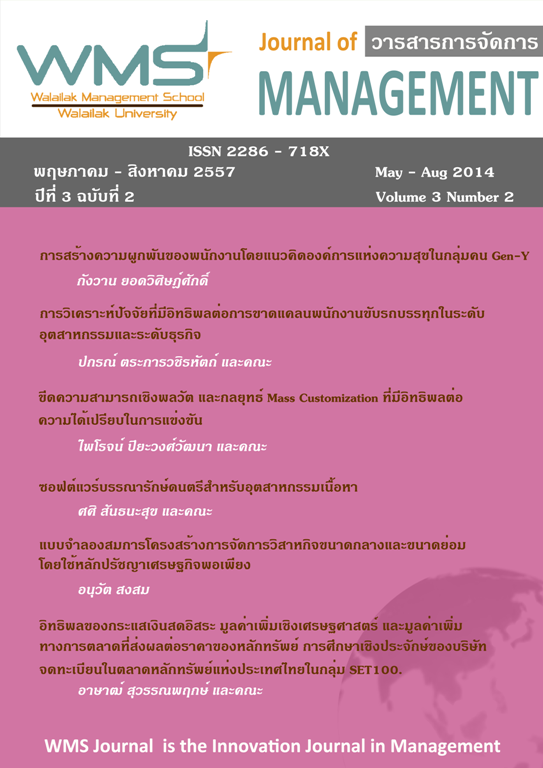The Influence of Free Cash Flow, Economic Value Added and Market Value Added to the Price Stock: The Empirical Study of the Listed Companies in the Stock Exchange of Thailand in SET100.
Main Article Content
Abstract
This research was conducted with the aim to study the relation and influence of Free Cash Flow, Economic Value Added and Market Value Added Effect to the Price stock. Using Structural Equation Modeling (SEM) to develop a model, to inspect consistency between the model and empirical data and to study the effects of factors. The listed 100 companies in the Stock Exchange of Thailand (SET100) were been used in this study. The study had been collected by the quantitative method using the set of financial budget and financial data, according to analyzing equation of each factor.
The results indicated that the model fitted the empirical data (Chi-Square = 0.00, df = 0, P-value = 1.0000, RMSEA = 0.00). It also revealed that the Economic Value Added has indirect effect on the price stock, Market Value Added has direct effect on the price stock and Free Cash Flow has direct effect on the price stock.Article Details
References
ณัฐกานต์ กู้วงศ์บัณฑิต. 2549. ความสัมพันธ์ระหว่างราคาตลาดของหลักทรัพย์ กับมูลค่าเพิ่มเชิงเศรษฐศาสตร์. วิทยานิพนธ์ปริญญามหาบัณฑิต จุฬาลงกรณ์มหาวิทยาลัย.
นริศรา นันตาภิวัฒน์. 2550. ความสัมพันธ์ระหว่างโครงสร้างเงินทุนกับมูลค่าเพิ่มเชิงเศรษฐศาสตร์ (EVA) ซึ่งส่งผลกระทบต่อราคาหลักทรัพย์และการจ่ายเงินปันผล กรณีศึกษา บริษัทในกลุ่มธุรกิจพัฒนาอสังหาริมทรัพย์. วิทยานิพนธ์ปริญญามหาบัณฑิต มหาวิทยาลัยธรรมศาสตร์.
บุศรินทร์ บูรณศักดา. 2545. การทดสอบทฤษฎีลำดับขั้นในการจัดหาเงินทุนของโครงสร้างเงินทุน. วิทยานิพนธ์ปริญญามหาบัณฑิต จุฬาลงกรณ์มหาวิทยาลัย.
จันวิมล ติรบรรเจิด. 2550. ความสัมพันธ์ระหว่างโครงสร้างเงินทุนกับมูลค่าเพิ่มเชิงเศรษฐศาสตร์ (EVA) ซึ่งส่งผลกระทบต่อราคาหลักทรัพย์และการจ่ายเงินปันผล กรณีศึกษา บริษัทในกลุ่มอุตสาหกรรมพลังงานและสาธารณูปโภค. วิทยานิพนธ์ปริญญามหาบัณฑิต มหาวิทยาลัยธรรมศาสตร์.
จันทิมา ว่องเจริญวัฒนา. 2550. ปัจจัยกำหนดโครงสร้างเงินทุนของบริษัทที่จดทะเบียนในตลาดหลักทรัพย์แห่งประเทศไทยช่วงก่อนเกิดวิกฤติเศรษฐกิจ และภายหลังเกิดวิกฤติเศรษฐกิจ. วิทยานิพนธ์ปริญญามหาบัณฑิต มหาวิทยาลัยวลัยลักษณ์.
ตลาดหลักทรัพย์แห่งประเทศไทย. 2556. ตลาดหลักทรัพย์แห่งประเทศไทย. สืบค้นเมื่อ 28 พฤษภาคม 2556, จาก http://www.set.or.th/th/index.html.
ธนาคารแห่งประเทศไทย. 2556. สถิติตลาดการเงิน. สืบค้นเมื่อ 28 พฤษภาคม 2556, จาก http://www.bot.or.th/Thai/Statistics/FinancialMarkets/Interestrate/_layouts/application/interest_rate/IN_Rate.asp
สังวรณ์ งัดกระโทก. 2554. เอกสารประกอบการอบรม หลักสูตรการใช้โปรแกรม LISREL สำหรับการวิจัย. ศูนย์วิทยาบริการ สุราษฎร์ธานี. มหาวิทยาลัยวลัยลักษณ์.
สำนักงานคณะกรรมการกำกับหลักทรัพย์และตลาดหลักทรัพย์. 2556. งบการเงิน. สืบค้นเมื่อ 30 เมษายน 2556, จาก http://capital.sec.or.th/webapp/corp_fin/cgi-bin/findFS.php.
สุเวช ปิยะรัตนวัฒน์. 2548. การวิเคราะห์ความสัมพันธ์ระหว่างมูลค่าเพิ่มทางเศรษฐศาสตร์กับราคาหุ้นของกลุ่มพลังงานในตลาดหลักทรัพย์แห่งประเทศไทยระหว่างปี ค.ศ. 2000-2004. วิทยานิพนธ์ปริญญามหาบัณฑิต มหาวิทยาลัยเชียงใหม่.
สุภมาส อังศุโชติ, สมถวิล วิจิตรวรรณา และรัชนีกูล ภิญโญภานุวัฒน์. 2552. สถิติวิเคราะห์สำหรับการวิจัยทางสังคมศาสตร์และพฤติกรรมศาสตร์: เทคนิคการใช้โปรแกรม LISREL. ครั้งที่ 1. กรุงเทพฯ: มิสชั่น มีเดีย.
ศูนย์ส่งเสริมการพัฒนาความรู้ตลาดทุน สถาบันกองทุนเพื่อพัฒนาตลาดทุน. 2554. ตลาดการเงินและการลงทุนในหลักทรัพย์. พิมพ์ครั้งที่ 11. กรุงเทพฯ: ตลาดหลักทรัพย์แห่งประเทศไทย.
Abate J., Grant J. and Stewart III G. BENNETT. 2004. The EVA style of investing. Journal of Portfolio Management 30: 61–72.
Brigham E. F. and Ehrhardt M. C. 2005. Financial Management. (11nd Edition). Thomson South-Western.
Chen Lin and Qiao Zhilin. 2008. WHAT INFLUENCE THE COMPANY’S ECONOMIC VALUE ADDED?: EMPIRICAL EVIDENCE FROM CHINA'S SECURITIES MARKET. Management Science and Engineering 2(1): 66-76.
Franco Modigliani and Merton H. Miller. 1958. The Cost of Capital, Corporation Finance and the Theory of Investment. The American Economic Review 48(3), 261-297.
JH de Wet and JH Hall. 2004. The relationship between EVA and MVA and leverage. Meditari Accountancy Research 12(1): 39–59.
JIANG FENG. 2007. Use EVA to Measure and Manage Shareholder Value in a Chinese Listed Corporation. Master of Business Administration the University of Nottingham.
Joel M. Stern, John S. Shiely and Irwin Ross. 2001. The EVA Challenge: Implementing Value-Added Change in an Organization. New York: John Willey & Sons.
Narayana T. Reddy. 2011. Valuation of Shareholders’ Wealth-An Empirical Analysis. European Journal of Humanities and Social Sciences. 1(1): 1-12.
Paulo S. 2010. The UK Companies Act of 2006 and the Sarbanes-Oxley Act of 2002 Implications for EVA (economic value added). International Journal of Law and Management. 52(3): 173-181.
PENG, FANG-FANG. 2008. The Relationship between Economic Value Added and Stock Price Returns in Thai Energy Sector. Master of Business Administration. University of the Thai Chamber of Commerce.
Stephen F. O’Byrne, Stern Stewart & Co. 1996. EVA AND MARKET VALUE. Journal of Applied Corporate Finance. 9(1): 116-125.
Stewart C. MYERS and Nicholas S. MAJLUF. 1984. CORPORATE FINANCING AND INVESTMENT DECISIONS WHEN FIRMS HAVE INFORMATION THAT INVESTORS DO NOT HAVE. Journal of Financial Economics. 13: 187-221.
Stewart, G. Bennett. 1991. THE QUEST FOR VALUE: a guide for senior managers. New York: HarperCollins Publishers, Inc.
Stewart C. Myers. 1993. Still Searching for Optimal Capital Structure. Journal of Applied Corporate Finance. 6(1): 80-95 Retrieved March 12, 2010, from http://www.bos.frb.org/economic/conf/conf33/conf33d.pdf.
Stewart C. Myers. 2002. FINANCING OF CORPORATIONS. Handbook of the Economics of Finance, 1-43.
Worthington, Andrew and West, Tracey. 2001. Economic Value-Added: A Review of the Theoretical and Empirical Literature. Asian Review of Accounting, 9(1): 67-86.
Young S. David and Stephen F. O'Byrne. 2000. EVA and value based management: a practical guide to implementation. New York: McGraw-Hill Co.


